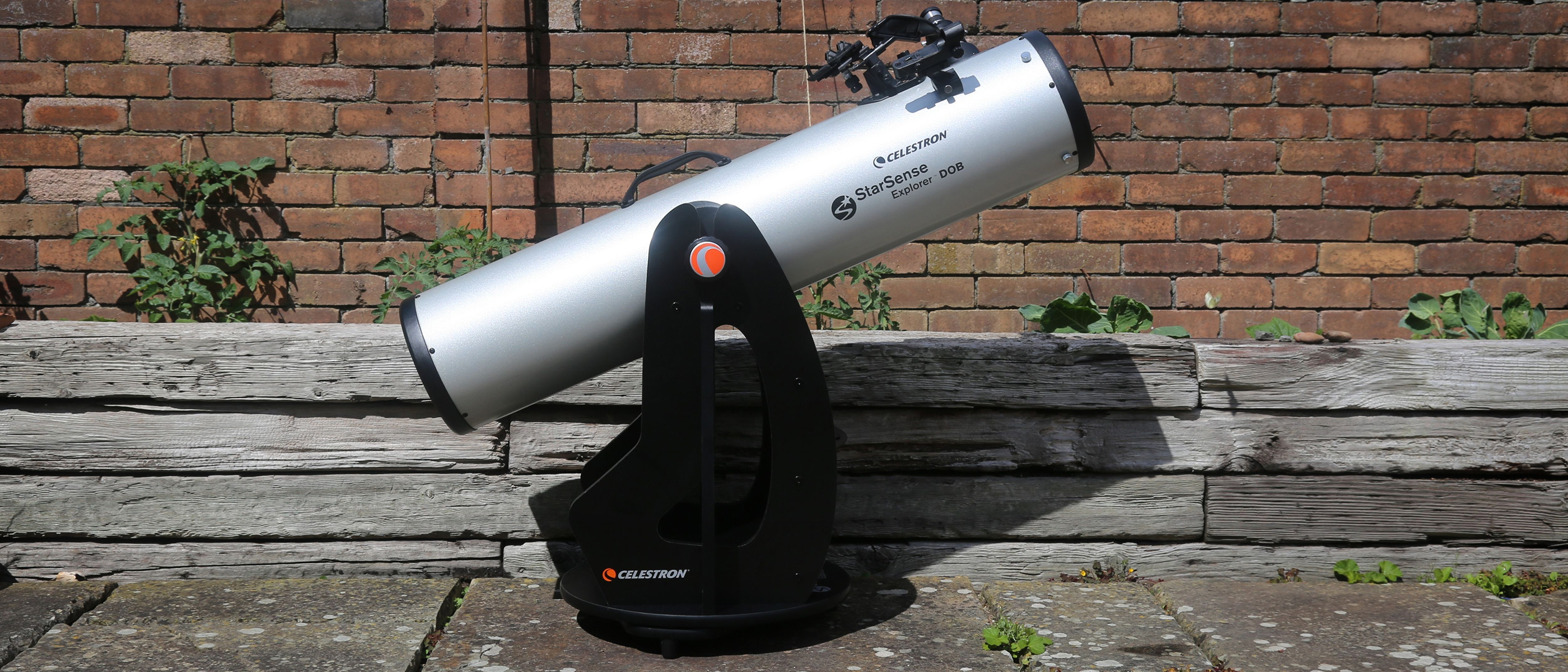Space Verdict
A great value all-rounder with the added convenience of alignment by smartphone, this large yet affordable Dobsonian telescope offers sharp and immersive views of galaxies, nebulae but also planets and the Moon.
Pros
- +
Aligns quickly using StarSense app
- +
Detailed views of deep-sky and solar system targets
- +
Precise focusing
- +
Excellent value
Cons
- -
Heavy to maneuver
- -
Difficult to store
- -
Primary mirror occasionally needs collimating
Why you can trust Space.com
The Celestron StarSense Explorer 8-inch Dobsonian telescope ($799.95/£649.99) couldn't come sooner. If you want the most bang for your buck when observing the night sky with a telescope you should always consider a Dobsonian. That's been a rule of thumb for years in the world of amateur astronomy, but Dobsonian telescopes are often ignored by beginners because their design means they have to be manually pointed at objects.
Optical design: Newtonian reflector
Aperture: 8-inches/203 mm
Focal length: 47.24-inches/1200 mm
Focal ratio: f/5.9
Eyepiece focal length: 0.98-inches/25 mm (48x)
Total kit weight: 43.4 lbs/19.68 kg
Mount type: Alt-azimuth Dobsonian
They're also very large, hard to move and difficult to store. Why bother when you can get a small, portable and computerized 'Go To' reflector telescope that finds objects for you?
Cue Celestron's unique StarSense tech, which finds objects using only a smartphone app. The telescope itself still needs to be manually pointed at objects, but StarSense makes that very easy by guiding you to targets in seconds.
With the arrival of the Celestron StarSense Explorer 8-inch — as well as a slightly larger aperture 10-inch version — are we witnessing the rebirth of the Dobsonian telescope?
Celestron StarSense Explorer 8-inch Dobsonian telescope: Design
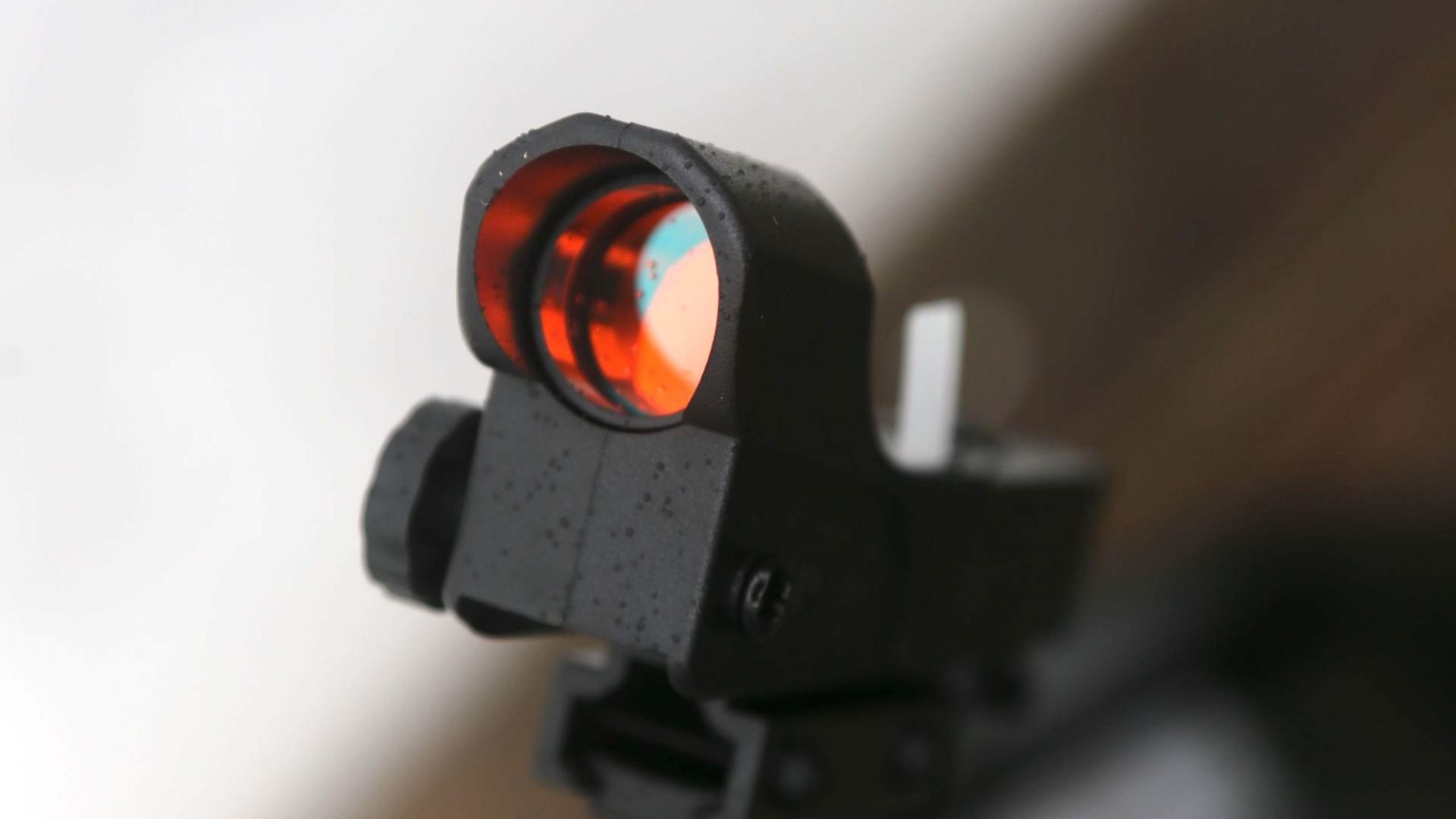
- StarSense Explorer dock
- StarPointer red-dot finderscope
- 2-inch Crayford focuser (with 1.25-inch adapter)
25mm Celestron Omni Plössl eyepiece
2" Crayford focuser
2" Extension Tube and 1.25" Adapter
StarSense smartphone dock
StarPointer red dot finderscope
Eyepiece rack
Carry handles
Collimation Cap
Celestron Starry Night Basic Edition Software
The Celestron StarSense Explorer 8-inch Dobsonian telescope is big. All Dobsonians are, relative to other designs of telescope mounts, but at least its 8-inch aperture limits it to about 10kg each for the base and the tube (the 10-inch version weighs 13.24kg and 11.6kg for the tube and base, respectively). It's a solid tube rather than a collapsible design, so it's not as easy to store when not in use. Aside from that this telescope has a rather impressive design that's packed with extras. Both the tube — which has a focal length of 1,200mm — and the base itself have built-in carry handles to make them easier to move. The latter also has an eyepiece rack (an excellent quality 0.98-inch/25 mm (48x) Celestron Omni Plossl eyepiece is included).

At the top of the Celestron StarSense Explorer 8-inch Dobsonian telescope's tube are three components; focuser, red dot finder and smartphone mount. Its Crayford focuser natively takes 2-inch eyepieces, though in the box is also an extender tube and an adaptor so you can use 1.25-inch eyepieces. There's also a StarPointer red dot finder in the box. Though technically you don't actually need this, it's there to help with alignment. It also gives you a quick way to point the telescope at the Moon, or if you want to use it during the day.
Celestron StarSense Explorer 8-inch Dobsonian telescope: Performance

- Limiting magnitude 14.2
- StarSense works in seconds
- Use wireless earphones to get audio descriptions
Despite its fancy smartphone app, the Celestron StarSense Explorer 8-inch Dobsonian telescope isn't a 'Go To' telescope. In fact, it's more of a 'Push To', with the StarSense app acting as a dynamic guide. StarSense works really well. During our test in a light-polluted city we were able to place an iPhone 12 Pro in the smartphone mount, uncover the small mirror positioned behind it and align its camera using X-Y adjustment knobs, and then let StarSense get busy taking photos of the night sky. That's essentially how it knows where it is, together with data from your phone's camera, gyro, accelerometer and GPS sensors.
Breaking space news, the latest updates on rocket launches, skywatching events and more!
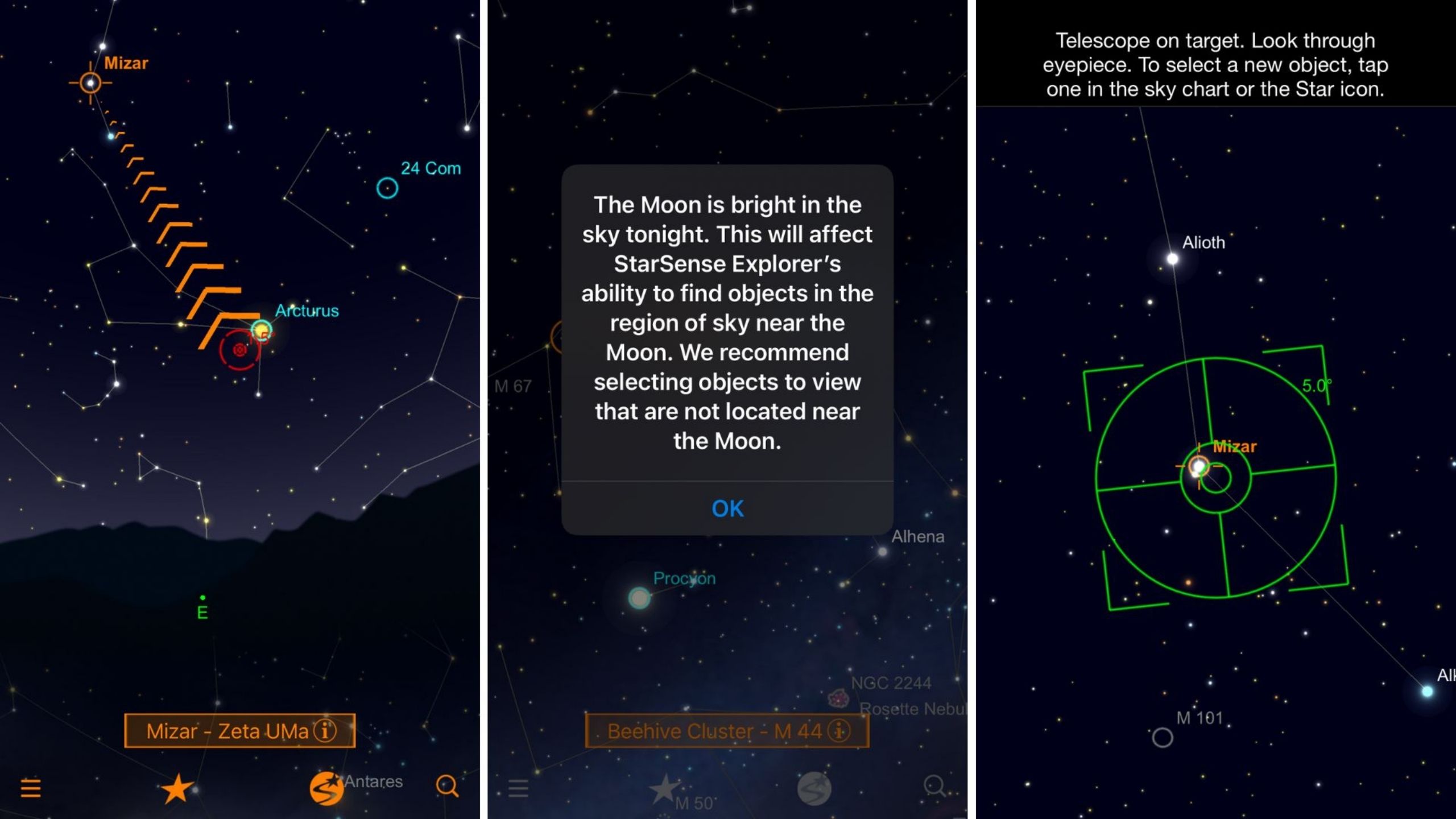
The app takes a little getting to know, but once you've got the hang of its arrows and the way the app zooms in as you get closer to your target, it's all very easy to use. How you find actual targets couldn't be easier. As well as issuing 'Push To' instructions, the StarSense app contains vast lists of celestial objects currently visible from your exact location. That catalog has massively expanded since the last time we looked at StarSense and now includes a plethora of deep-sky objects perfect for training a Dobsonian on. It's also worth observing while wearing some wireless Bluetooth earphones because the StarSense app has an audio description for each major object you point the telescope at.

When the bullseye turns green you're ready to observe — and the views on offer are truly excellent. Bright stars have a slight four-pronged starburst (though Celestron's XLT reflective coatings keep these diffraction spikes to a minimum). In our test, we easily split double stars, with fine views of the red and blue companions in Albireo in Cygnus. Ditto the 'double double' close to Vega in Lyra. Saturn, although close to the horizon, clearly displayed its ring pattern. However, it's with the deep sky that this 'scope truly excels. Objects look sharp, detailed and contrasty. The clarity in the great globular cluster in Hercules (M13) was mesmerizing, and so was the Andromeda Galaxy (M31). It's easy to make reasonably fine adjustments to the field of view by slightly moving the tube (although you do have to get used to the inverted image) while the focus wheel is perfectly calibrated and works really well. Optically speaking this Dobsonian is an incredibly impressive product — and excellent value for money.
Celestron StarSense Explorer 8-inch Dobsonian telescope: Functionality
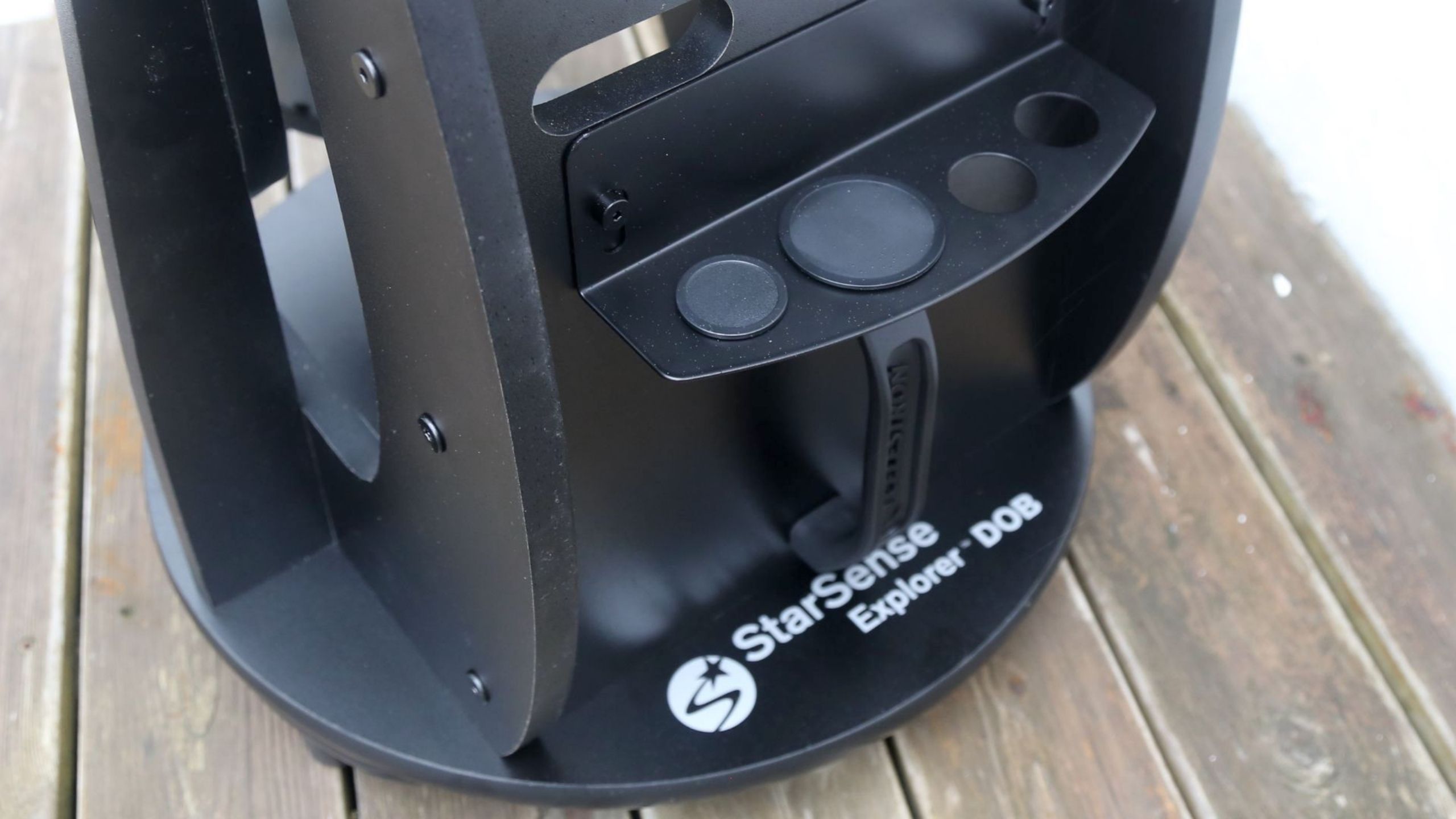
- Useful carry handle on tube and base
- Can attach a camera
- Needs occasional collimation
The Celestron StarSense Explorer 8-inch Dobsonian telescope is easy to use. It's partly thanks to the StarSense app, of course, which makes aligning it incredibly easy. However, even without that flashy app, this is a telescope that has a decent enough build quality to work without much fuss. Its metal focus knobs work smoothly and precisely as does the panning knob. We found it simple enough to maneuver the tube while the base has smooth movements and high-quality bearings. It's rigid enough, though it does require a little tweaking if you're spending the evening inspecting targets at the zenith. It's also worth remembering that the mount is such that when looking at things close to the horizon the optics are fairly close to the ground — so an open observing location is recommended. The carry handles on both the tube and the base proved really useful.

However, there are three small issues with using a smartphone app to align a telescope. No, not light pollution — the StarSense method appears to be able to cope with that. The first problem is the initial alignment, which requires the user to point this telescope at a bright star and corroborate it with the mirror image shown on the StarSense app. It's therefore necessary to have a deep twilight and a bright star (we used Vega). It's not difficult but it will trip up some absolute beginners. The second minor issue is the cloud. Since the software regularly plate-solves the stars it sees in the smartphone mirror just before issuing the final close-in bullseye, it requires a clear sky, so stargazing through gaps might cause it to lose itself. The third issue is that by leaving a smartphone in the cradle you haven't then got access to your usual smartphone app for stargazing or your smartphone's camera for some quick afocal lunar astrophotography. The latter is easily possible on the Celestron StarSense Explorer 8-inch Dobsonian telescope, though you can also attach a manual DSLR or mirrorless camera to the focuser using a T-adaptor.
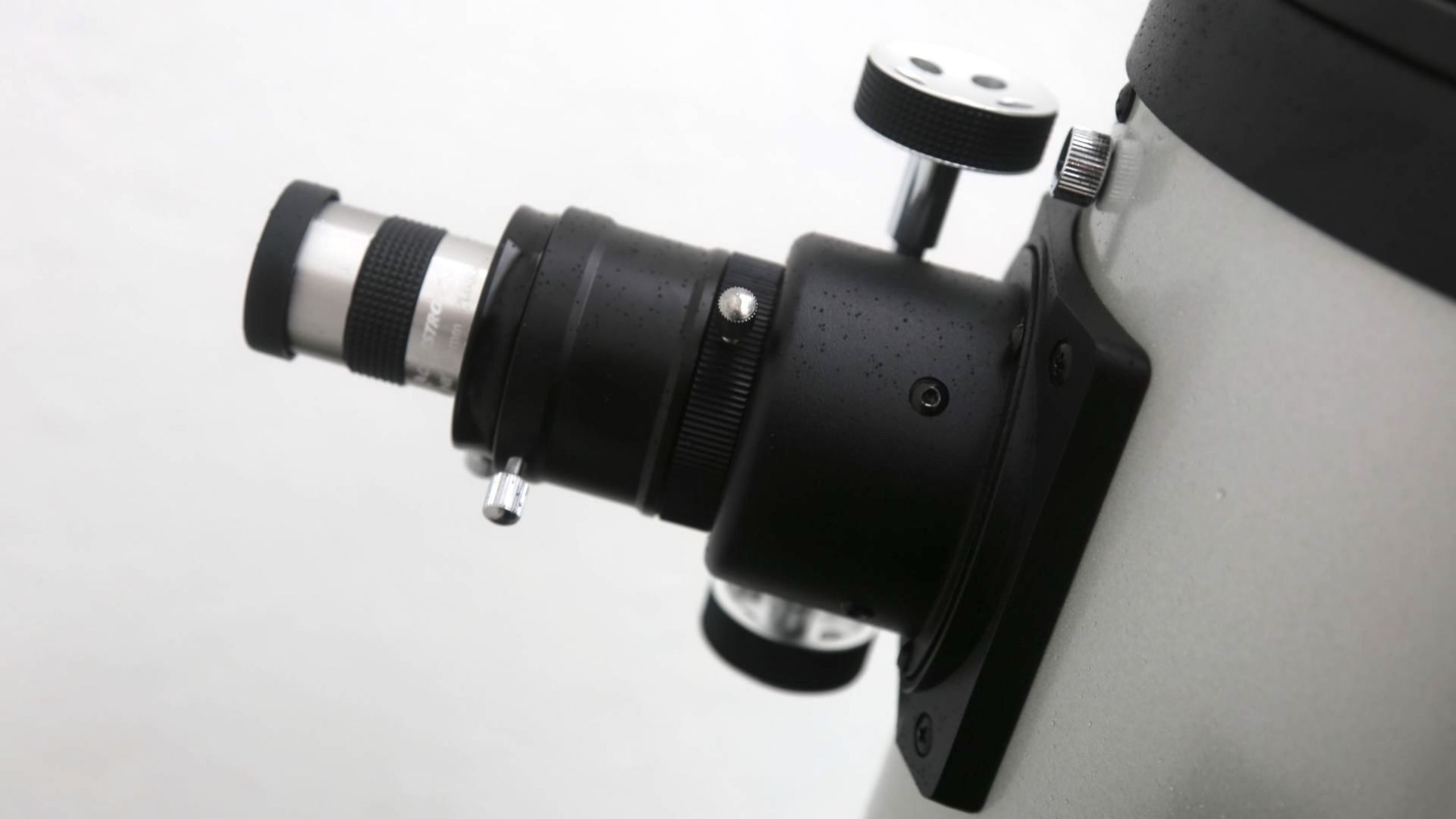
For all their simplicity and supreme light-gathering powers, there's something about Dobsonians — and all Newtonian reflectors — that aren't very beginner-friendly. This telescope needs to be collimated, which basically means it needs to have its components specifically aligned to bring light to its best focus. That requires an Allen head wrench and a Phillips head screwdriver, which is a bit of a fiddle, but at no point during our review did we need to do this despite the product being in transit.
Should you buy the Celestron StarSense Explorer 8-inch Dobsonian telescope?
The Celestron StarSense Explorer 8-inch Dobsonian telescope is a hugely impressive telescope. Although we're sure beginners could get used to it, it's primarily aimed at intermediate users after a good quality, good value Dobsonian telescope and who have the confidence to manually aim it. As such it's a great telescope for learning the night sky, too. However, it's not lightweight. Although there are some excellent handles to carry the tube and the base separately — and it's easy enough to swivel and pivot once in place — a telescope this size requires some careful consideration. However, if you have the space it comes highly recommended and should give you many years of incredible deep sky views.
If the Celestron StarSense Explorer 8-inch Dobsonian telescope isn't for you
If you like the sound of StarSense but need a more compact telescope then consider the Celestron StarSense Explorer DX 102AZ, which is a must-have for beginners. If you want an even larger Dobsonian telescope and you're happy to manually aim at targets then the Sky-Watcher Flextube 300 SynScan Dobsonian's 12-inch aperture will access the deep sky. For kids, a mini-Dobsonian is also available in the shape of the Celestron FirstScope 76, though it's only good enough for Moon-viewing.

Jamie is an experienced science, technology and travel journalist and stargazer who writes about exploring the night sky, solar and lunar eclipses, moon-gazing, astro-travel, astronomy and space exploration. He is the editor of WhenIsTheNextEclipse.com and author of A Stargazing Program For Beginners, and is a senior contributor at Forbes. His special skill is turning tech-babble into plain English.
